Mango Fruit Varieties in India: A Comprehensive Guide
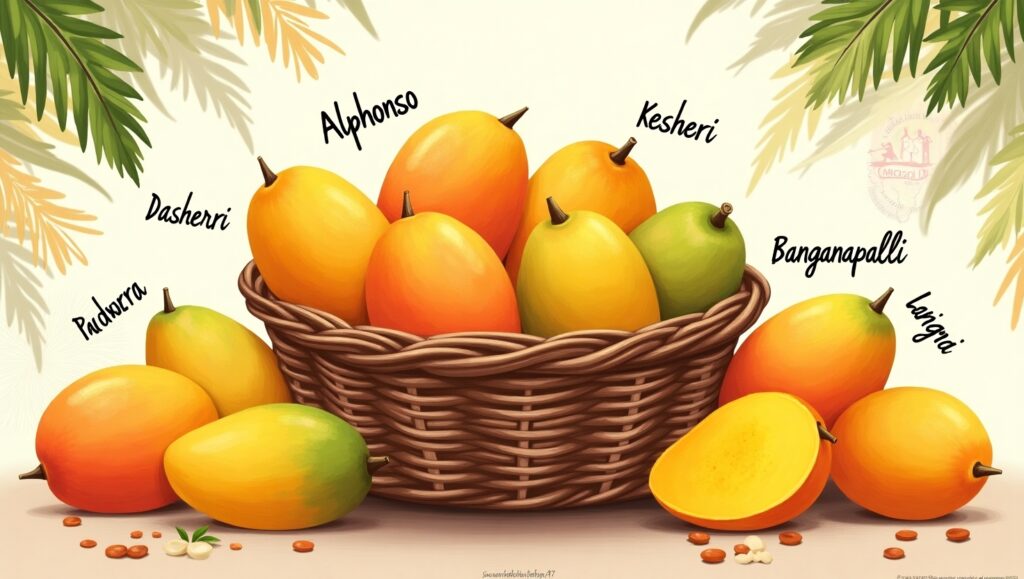
Introduction to India’s Mango Heritage
Mangoes have a special place in India’s historical, cultural and economic sphere. The mango is known for being the “King of Fruits,” the mango isn’t just an annual summer treat as it is deeply embedded in Indian culture and festivals, literature, and food. Folklore and texts from the past often refer to mangoes as symbols of happiness love, abundance, and happiness. Today, even the leaves of mango are utilized in religious ceremonies and also as ceremonial decorations at festivals.
India is the biggest producer of mangoes around the globe with more than 40% of the world’s production. From the sun-soaked orchards of Maharashtra through the fertile plains of the river in Uttar Pradesh, mango cultivation covers almost every region in the country. Each state has its own unique flavor and is influenced by particular climate, soil and cultivation techniques.
With more than 1,000 varieties of mango produced across the nation, India offers an unmatched variety of flavor, color as well as size and texture. This diversity is not limited to the needs of consumers in India, but also helps to support a flourishing export market, which makes mangoes an important part of the Indian economy of agriculture.
Classification of Mango Varieties
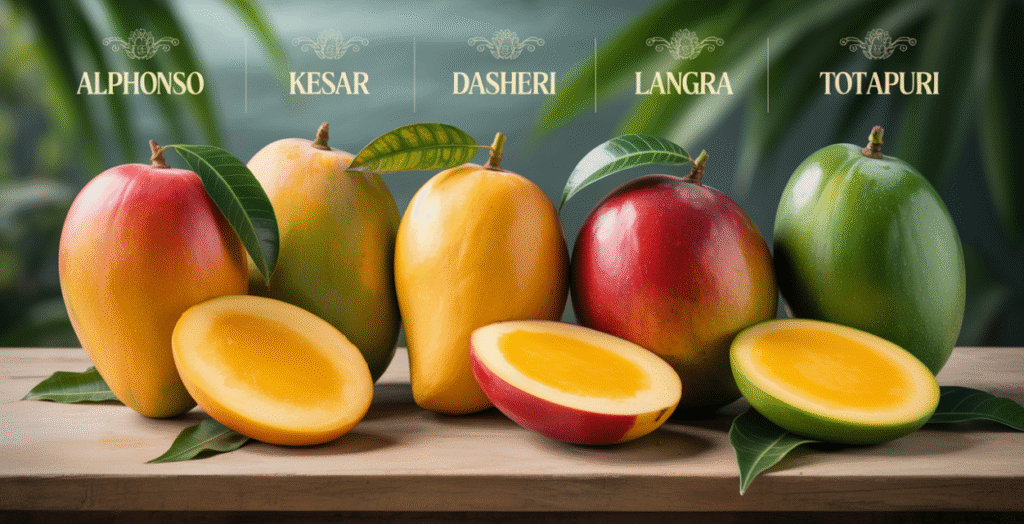
Mango varieties from India can be broadly classified in accordance with the harvesting season that are early, mid and late. This classification assists farmers in planning cultivating cycles and lets consumers take advantage of fresh mangoes throughout summer.
Early-Season Mango Varieties (April to Early May)
These varieties begin to ripen during the growing season providing an excellent mango taste to fans across the nation.
- Bombai (West Bengal): A sweet, fragrant mango with a distinct flavor and very little fiber.
- Himsagar (West Bengal): It is famous for its silky, spongy taste and smooth texture.
- Kesar (Gujarat):Often known as”the “Queen of Mangoes,” this variety is well-known due to its saffron-colored flesh as well as the rich flavor.
Mid-Season Mango Varieties (Mid-May to June)
The mangoes are the main focus of the mango season and are easily sold in markets.
Alphonso (Hapus) (Maharashtra) is a favorite for its smooth texture, aromatic aroma and sweet taste.
- Alphonso (Hapus) (Maharashtra):It is favorite for its smooth texture, aromatic aroma and sweet taste.
- Dashehari (Uttar Pradesh):A popular northern drink is known for its pulp that has no fiber and mellow, sweet taste.
- Langra (Uttar Pradesh/Bihar):The fruit is green even when the fruit is ripe. Langra is adored for its tangy sweet flavor.
Late-Season Mango Varieties (Late June to July)
The mangoes prolong the mango season into July, and can even be harvested in early August in some areas.
- Fazli (West Bengal/Bihar): Large-sized, with fibrous flesh, ideal for use in pulp-based applications.
- Neelum (Tamil Nadu): Sweet and aromatic usually consumed at the end of the season.
- Chausa (Uttar Pradesh): Astonishingly juicy with an honey-sweet taste and a smooth texture.
This diversity of seasons makes sure that mango lovers in India can enjoy a constant variety of tastes between April and July.
Alphonso (Hapus) – Maharashtra
It is often referred to for being the “King of Mangoes,” Alphonso is one the most desirable and sought-after mango varieties that are grown in India. It is cultivated primarily within the Konkan region of Maharashtra and in particular Ratnagiri, Devgad, and Sindhudurg, Alphonso is celebrated by its smooth, rich texture and its intensely aromatic scent.
The fruit has a bright golden-yellow, golden-yellow rind that is adorned with red blush. It also has a fibrous, creamy pulp that melts in your mouth. The perfect balance of sweetness and tangy flavor makes it a great fruit to eat fresh, or in desserts such as aamras, smoothies, and ice creams.
Alphonso mangoes also carry Geographical Indication (GI) tag designation, distinguishing them from imitations and guaranteeing their authenticity on the international and domestic markets.
Their short duration that typically runs between mid-April and the beginning of June makes them more sought-after by mango-lovers.
Kesar – Gujarat
Also known as the “Queen of Mangoes,” Kesar is a sought-after variety that is grown mostly within the Gujarat’s Gir as well as Junagadh regions. Its name is derived because of its striking saffron-colored fruit (“kesar” is saffron-related meaning saffron in Hindi) as well as being loved by its sweet, sour taste.
The mangoes of Kesar have a oval shape, with a golden-yellow skin and a delightful scent. The pulp is soft, succulent and moderately fibrous making them a great choice for eating fresh as well as processing.
The most awaited uses for Kesar can be found in the aamras. This is an Indian traditional mango puree consumed in summertime meals throughout western India. The natural sweetness and bright color can also be used in desserts, milkshakes and preserves.
Kesar is a recipient of Kesar is tagged with a Geographical Indication (GI) tag which recognizes its origins and distinctive features. The season of harvesting usually starts in May, and lasts through June, which makes it one of the earliest-to-mid-season mango varieties.
Dashehari – Uttar Pradesh
Dashehari is among the most famous mango varieties in India that is known for its fibrous pulp and a delicious sweetness. It was developed during the 1800s, from in the garden of Nawab of Lucknow This variety has a long history and is a top choice across northern India.
Dashehari mangoes are medium-sized and have a the skin which is greenish-yellow and turns golden when they mature. The pulp is smooth and juicy. They are also non-fibrous making them suitable to eat fresh or making into aamras or smoothies.
The variety is cultivated extensively and is widely grown in Malihabad, Uttar Pradesh, one of India’s biggest mango-growing zones, which is often called”the “Mango Capital of India.” Actually, Malihabadi Dashehari holds a Geographical Indication (GI) tag which emphasizes its distinctive regional character and its superior quality.
Dashehari mangoes typically arrive at market in June, which marks the start of the peak mango season North India.
Langra – Uttar Pradesh
Langra is a distinct mango variety that is native of Varanasi, Uttar Pradesh, famous for its greenish skin that remains green when it is fully mature. What separates Langra from other varieties is the sweet and sour taste that is refreshing and incredibly satisfying.
The mango has a somewhat oval shape, and an elongated green peel that surrounds its juicy, spongy and extremely aromatic pulp. Langra is particularly popular with those who appreciate mangoes with the perfect balance of tang and sweetness, making it ideal for fresh consumption and for use in chutneys and cooling drinks for summer.
The term “Langra,” meaning “lame” in Hindi it is believed to come from a farmer who was disabled and first started cultivating the crop several centuries ago. This is an interesting story that contributes to the local appeal and heritage.
The Langra Mangoes are harvested from the middle to late of June and their delicious flavor and aroma makes them a popular seasonal fruit throughout North India.
Banganapalli (Safeda) – Andhra Pradesh
Banganapalli Also called Safeda is a well-known mango variety that comes from Andhra Pradesh, particularly the town of Banganapalle within the Kurnool district. It’s among the first mangoes to be introduced to the market and is extensively planted throughout the southern region of India.
It is distinguished by its vibrant yellow skin and its fibrous, spongy fruit, Banganapalli mangoes offer a mildly sweet to a slightly sweet taste that is appealing to all kinds of taste buds. The texture is soft and delicious and makes it a preferred option for desserts, milkshakes as well as making salads.
This variety is notable due to its huge size and lengthy shelf life, which makes it a preferred choice for export and transport. The Banganapalli mangoes were also among the first ones to receive an Geographical Indication (GI) tag from Andhra Pradesh, affirming their authenticity and significance to the region.
Typically, they are available from April through the end of June. Banganapalli Mangoes can be a delightful way to start the the mango harvest season of South India.
Himsagar – West Bengal
Himsagar is an extremely sought-after variety of mango that comes out of West Bengal, known for its soft, fleshy yellow pulp as well as its delicate sweetness. This mango is truly a delight, renowned by its soft texture and silky flesh that is not fibrous and melts in your mouth with each bite.
Himsagar mangoes possess a distinctive scent and a slight tart taste that is perfectly balanced with their sweet sweetness. Their short harvest timegenerally from May through early June — contributes to their specialness which makes them a seasonal prize. Although they are not widely available Himsagar mangoes are a huge hit with mango lovers who are eagerly waiting for this coveted variety to be available in the market.
Most commonly grown in the Murshidabad in the Murshidabad and Nadia districts in West Bengal, the Himsagar variety is widely thought of as one of the best mangoes found in Eastern India.
Totapuri – Karnataka
Totapuri is also referred to as Kesarapalli is a distinctive mango variety that is grown primarily within Karnataka, Andhra Pradesh, and Tamil Nadu. What is immediately distinct about Totapuri the mangoes from other varieties is their unique parrot-like shape and their greenish-yellow skin even if they’re fully mature.
This variety is renowned for its tart, slightly sweet flavor that makes it distinct from more sweet mango varieties that are found in India. The fibrous, firm pulp is ideal to use in pickles, salads and chutneys which is where its sharpness and texture provide a wonderful contrast. It’s also a sought-after fruit juice ingredient because of its refreshing, slightly tart flavour.
Totapuri mangoes can be found throughout the summer season, from April to June. They are particularly appreciated due to their long shelf-life making them a breeze to move and export.
Neelam – Tamil Nadu
Neelam is a well-loved mango variety, primarily grown within Tamil Nadu and parts of Andhra Pradesh. The variety is famous for its vibrant red skin Neelam fruit is as stunning as they are tasty. The sweet, fragrant flesh is smooth and juicy which makes it a favourite for people who love mangoes.
Neelam mangoes are characterized by an exotic scent which makes them stand out among other mango varieties. The moderate sugar content and the low content of fiber allow them to be used in various applications, including desserts and drinks for summer. For mango sorbets or milkshakes, ice creams or used as a topping for fruits salads Neelam mangoes add a fresh, tropical flavor to food items.
Most often, they are harvested between June and July. Neelam mangoes provide a sweet ending to the mango harvest season throughout Southern India.
Malgova – Tamil Nadu
Malgova is a huge and distinct mango variety that is native of Tamil Nadu. The Malgova mango is known for its huge size and bright white skin Malgova is often considered to be a superior variety because of their distinctive blend of tanginess and sweetness.
The mango is a soft fibrous pulp that is equally sweet and tangy, with a flavor that is loved by many lovers of mango. The aroma is among its most distinctive characteristics that makes it a pleasure to drink fresh or use in many cooking applications.
Malgova is well-known for its mango jams, fruits as well as pickles. its strong flavor is ideal for desserts. It is primarily grown throughout regions like Kanchipuram as well as the Chennai areas within Tamil Nadu, Malgova is accessible during the summer months (from May through June) and its strong taste makes it a favourite by those who like mangoes that have a slight tart edge.
Fazli – West Bengal
Fazli is a huge-sized mango variety that is widely grown across West Bengal and Bihar, well-known for its thick fibrous flesh, as well as its mildly sweet taste. Although it isn’t as well-known like other mango varieties Fazli is a favorite with a loyal audience due to its distinct flavor and large size.
The extremely fragrant mango has a bright green skin, and a firm fibrous pulp that may be difficult, but it is a pleasant bite. Despite its fibrous appearance, the pulp is soft and sweet having a sweet tang which is ideal for transforming into chutneys, mango pulp, or mango pulp.
The Fazli Mangoes are usually harvested from late June through July. Their larger dimensions make them an ideal choice to make aamras as well as other desserts during summer. Because of their flavor they are commonly utilized in mango-based drinks and desserts, providing less sour taste than other varieties.
Amrapali – Bihar
Amrapali is a hybrid mango cultivar that originated in Bihar which is known for its ability to produce fruit consistently and in a reliable manner throughout the season. It is the result of a cross between Dashehari as well as Langra and combines the best traits of both varieties that include a soft non-fibrillous texture, as well as a tasty, sweet and rich flavor.
Amrapali mangoes are high in carotenoids. They provide them with their bright golden-orange color, and also contribute to their nutritional value. The fruit is characterized by a mild aroma, fragrant scent and a subtle sweetness, with some tang, making it delicious fresh or when processed into smoothies, juices, and desserts made with mango.
The ideal choice for regions with humid conditions, Amrapali is widely grown in regions with high levels of moisture such as Bihar, West Bengal, and a portion in Uttar Pradesh. The consistent nature of its fruit bearing is a popular choice by farmers since it yields high-quality fruit throughout the season, generally between May and June.
Mallika – Karnataka
Mallika is a high yielding hybrid mango variety that was developed in Karnataka and is renowned for its reliable performance in different regions. It is a cross of Neelum as well as Dashehari Mallika fruit inherits the most desirable traits of both of their parent varieties, which results in a mango that is delicious, juicy, and fragrant.
Mangos are medium-sized and has smooth, non-fibrous flesh which has a slight sweet, refreshing taste. Its mildly tangy flavor complements the overall flavor and makes it a popular choice to eat fresh and also in smoothies, desserts, and salsas. Mallika Mangoes, too, are sought-after for their consistent fruit production which makes them a preferred option for commercial cultivators.
Due to its ability to withstand various weather conditions Mallika excels across diverse regions, from humid plains to the cooler regions, which is why it has its spread throughout South India, especially in Karnataka and Maharashtra.
Raspuri – Karnataka
Raspuri is a favored mango variety that comes from Karnataka that is recognized for its oval-shaped fruits and its reddish-yellow, yellow skin. The smooth, soft flesh is coveted because of its sweet, rich taste and the intensely fragrant scent that makes it a favourite for mango lovers.
Raspuri mangoes are astringent with a juicy and succulent pulp that provides the perfect blend of sweetness with tartness. The distinct flavor profile of the fruit along with its sweet scent is a great option for fresh consumption and for use in smoothies, mango juices and desserts.
Typically, they are harvested from May to typically harvested from May to Raspuri mangoes are a bit of a shorter season, making them more sought-after during their availability. Most of them are grown within regions like the Mysuru as well as Davanagere areas within Karnataka, Raspuri mangoes are an integral component of the state’s mango-growing tradition.
Pairi – Maharashtra
Pairi is a smaller-sized mango variety grown extensively in Maharashtra and other parts of Gujarat. Despite its small dimensions the fruit packs a powerful punch of taste, with the sweet and sour flavor that will appeal to people who like the tangy aspect of their mango-based experience.
The mango is renowned for its soft, spongy flesh, making it an ideal fruit to eat fresh and also for the making of mango pickles and chutneys. Its silky flesh and delicious pulp add to its versatility for both sweet and savory cooking applications.
The majority of them are harvested in June. Pairi mangoes are harvested in a brief harvest period, which adds to their appeal during the summer months. Their unique sweet-tart taste and compact, lightweight size make them an ideal choice for snacks during the summer months.
Suvarnarekha – Kerala
Suvarnarekha is a delicious mango variety that is primarily grown in Kerala and is renowned for its soft yellow skin and delicious, juicy flesh. The bright golden color and delicately smooth texture make it a desirable and highly sought-after fruit, especially in the summertime.
Suvarnarekha’s pulp is extremely sweet and spongy and refreshingly sweetness that makes it perfect for fresh consumption as well as processing. Suvarnarekha is especially popular for the preparation for mango ice creams, juices and smoothies, where its luscious flavor and silky texture are evident.
The harvest is typically from between May and the month of June. Suvarnarekha mangoes can be a popular choice for those looking for the tropical flavor of fruits. The variety is highly regarded for its consistent fruit bearing ability and its capacity to flourish in moist climates, which makes it the perfect choice for Kerala’s landscape of agriculture.
Regional Mango Specialties
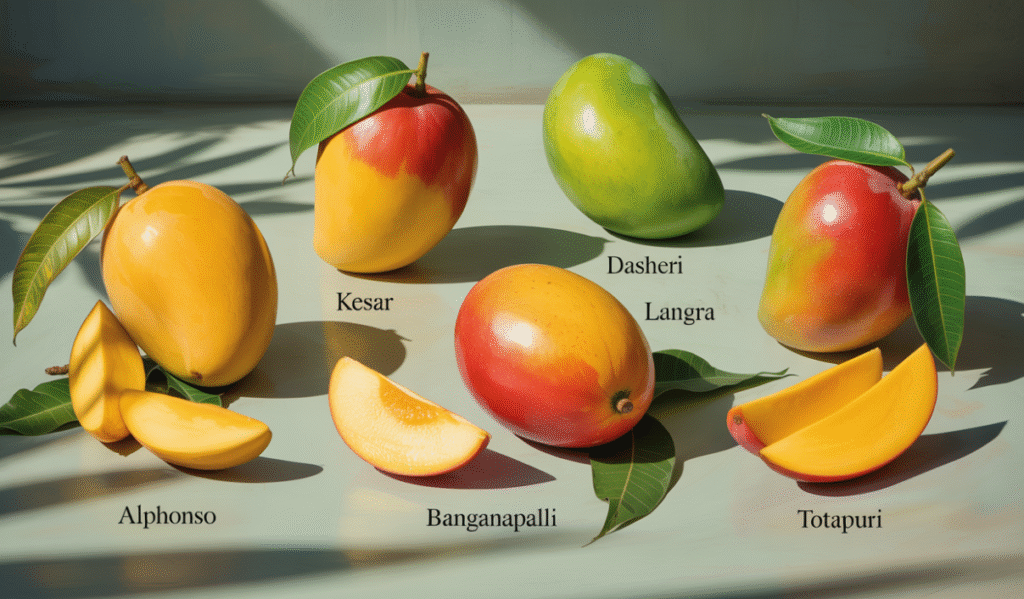
India is home to an amazing variety of varieties for mango, all one displaying the diverse cultural and regional tastes in the nation. From the tropical beaches and fertile plains in the north, each region is home to distinct mango varieties, prized by their distinct flavors and textures as well as their use in regional dishes.
Unique Mango Varieties Specific to Indian States
- Maharashtra – It is a state that is famous for its well-known Alphonso (Hapus) and the state also produces other varieties such as Kesar and Pairi and are loved for their aroma and sweetness.
- Uttar Pradesh – Home to the famous Dashehari, Langra, and Chausa, Uttar Pradesh is well-known for its mangoes that have become an important part of regional celebrations and rituals.
- West Bengal – The state’s most sought-after varieties is Himsagar which is known for its soft fiberless texture. Fazli is also adored by its aroma and subtle sweetness.
- Andhra Pradesh – Known for Totapuri and Banganapalli, Andhra Pradesh is famous for its mango varieties that have an astringent taste, which is commonly used to make pickles and juices.
- Tamil Nadu –Malgova and Neelam mangoes, which are known for their aromatic, rich flavor and firm flesh are very popular by the Tamil Nadu region to prepare fresh desserts and snacks.
- Kerala – The Suvarnarekha mango with its silky white skin, and yellow flesh is a top choice for ice creams, juices or smoothies from Kerala.
Cultural Significance and Regional Preferences
Mangoes have a place of the highest significance to the culture of India. Mangoes are not only an occasion to enjoy, but it also plays an integral part in many rituals, festivals and celebrations. In the southern part of India mangoes are frequently utilized in traditional mango pickles and rice, in northern states, mangoes are often consumed as a part of the aamras, as well as other desserts.
Different regions also favor distinct varieties of mango due to the local climatic conditions and tastes. For example, North India tends to prefer mangoes such as Dashehari, Langra, and Alphonso, whereas South India cherishes varieties like Kesar, Totapuri, and Banganapalli due to their unique taste and adaptability to climate.
Alongside their culinary value they are also symbolic in Indian tradition. In the celebration of Mangoes (celebrated in various regions) families and groups gather to enjoy the fruit. Mango leaves are commonly utilized for ceremonial and decorative reasons, indicating the abundance and prosperity.
Mango Varieties with Geographical Indication (GI) Tags
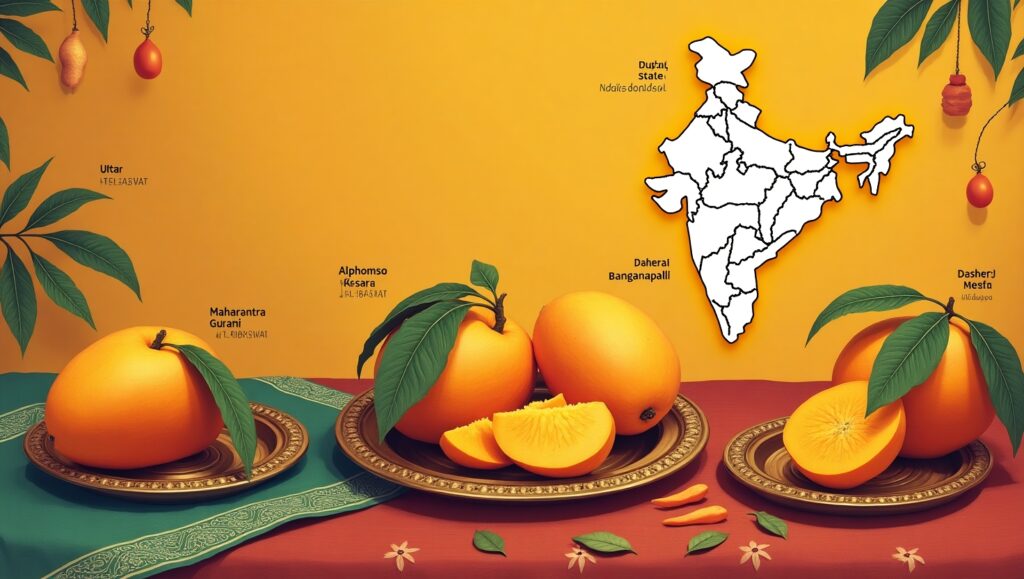
Geographical Indication (GI) tags are awarded to those products with distinctive qualities or a reputation because of their geographical origin. The mango’s GI tags recognize the distinct flavors as well as the cultivation techniques and traditions of particular varieties, granting them legendary status. Here are a few of the famous mango varieties from India with G.I. tags:
Malihabadi Dashehari – Uttar Pradesh
Malihabadi Dashehari can be described as a well-known mango variety that comes from Malihabad, Uttar Pradesh, that has been given the GI designation due to its distinct flavor and scent. It is renowned for its pulp that is not fibrous and sweet taste it has grown to become an emblem of North India’s mango tradition. Malihabadi Dashehari is sought-after during the peak mango season, which runs from May to June. It is prized for its deliciousness and soft texture. It is the Malihabad region is known for the most delicious Dashehari mangoes. They are frequently exported to other countries.
Gir Kesar – Gujarat
Gir Kesar, also referred to as King of Mangoes is a product of the Girnar Hills of Gujarat and is among the most sought-after varieties of the nation. The GI label for Gir Kesar honors its unique sweetness, sweet flavor, and fragrant scent that differentiates it from other varieties of mangoes. This variety is firm and fibrous pulp that is ideal to make juices, desserts and sweets. The skin is greenish-yellow and Gir Kesar ripens to a vibrant orange, which makes it visually as well as tasty. Gir Kesar is a region in the southwest of India. Gir region is famous for its ideal climate that are responsible for the mango’s top quality.
Himsagar – West Bengal
Himsagar Mangoes, which are grown throughout the Murshidabad as well as Nadia districts in West Bengal, are known for their soft, non-fibrinous pulp and their tropical scent. The GI label for Himsagar is a tribute to the distinctive flavor and high-quality of mangoes grown in this area. The short time of the season (usually from May to June) the mangoes are particularly appreciated due to their sweet and rich flavor and very aromatic. Himsagar mangoes are typically used to create mango pulp to make canned products, however they are best consumed fresh due to their juicy, velvety flavor.
Appemidi – Karnataka
Appemidi is a famous mango variety of Karnataka which has earned the GI designation due to its distinctive tartness and tiny size. Appemidi is a particular favorite by pickles and traditional meals. The mango’s tough skin and fibrous pulp makes it ideal for processing and long-term storage. Appemidi mangoes are typically harvested between April and May and form integral to Karnataka’s mango cultivation. The Appemidi region is blessed with an arid, warm climate, which contributes to the unique flavor of mangoes that makes it an outstanding choice among Indian mango varieties.
Hybrid Mango Varieties Developed in India
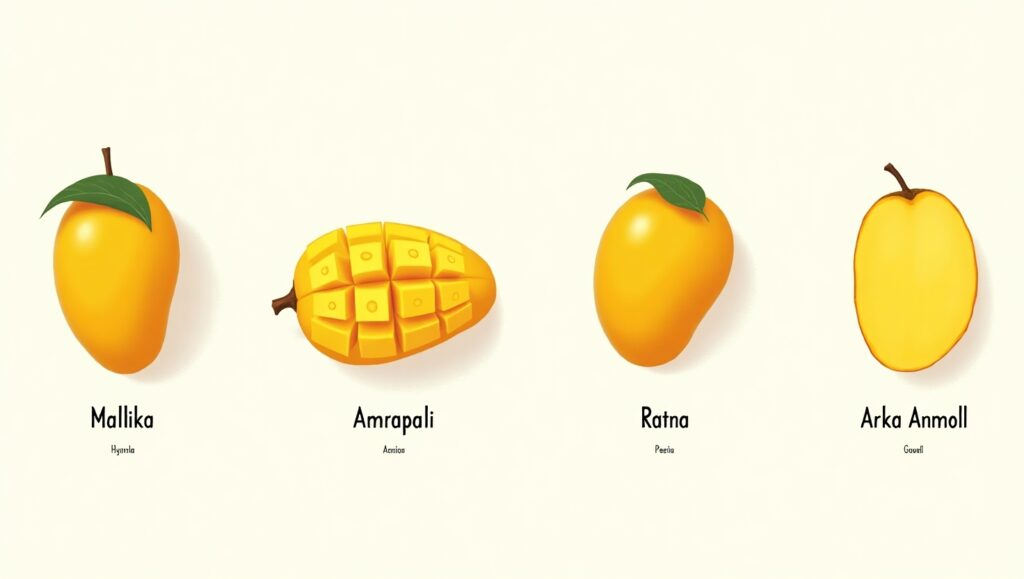
India is a country with a abundant mango-growing tradition It has also been in the forefront of the development of the hybrid varieties, which incorporate the best characteristics of two distinct varieties. The hybrid mangoes typically have better flavor as well as disease resistance and a higher yield and are highly sought-after by both farmers as well as consumers. Here are a few of the most well-known hybrid mango varieties that originated in India:
Amrapali (Dashehari × Neelum)
Amrapali is an hybrid mango variety that was created by crossing Dashehari as well as Neelum mangoes. It combines the best qualities of both varieties with a sweet, aromatic and a non-fibrinous flesh. Amrapali mangoes are medium sized with a soft golden skin, with a tangy, sweet taste that make them a favourite to eat fresh and also in juices, smoothies, and desserts. They are known for their regular fruit-bearing capacity, Amrapali is grown widely throughout Bihar, West Bengal, and Uttar Pradesh. It is prized due to its prolific yield and its resilience to various conditions of climate.
Mallika (Neelum × Dashehari)
Mallika is a hybrid mango variety that results from the crossing with Neelum as well as Dashehari. This variety is known for its strong, astringent flavor and juicy, fibrous pulp. The mango is medium-sized to large and has an attractive orange-yellow skin. Mallika mangoes taste sweet with an underlying tanginess that makes them perfect for fresh consumption, mango desserts and juices. Mallika is a highly yielding variety that is renowned due to its capacity to produce the fruit in a consistent manner. It is a favorite throughout South India, particularly in Karnataka and Maharashtra and is appreciated for its reliability and its ability to withstand diverse climates.
Arka Puneet (Alphonso × Janardhan Pasand)
Arka Puneet is a hybrid mango variety that was created by crossing the renowned Alphonso with the Janardhan Pasand. The variety is known for its rich taste and silky, non-fibrous texture, Arka Puneet mangoes are extremely sought-after because of their sweet and aromatic flavor. The variety ranges from medium-sized to large and features a golden-yellow, translucent skin, which is typical of Alphonso. The pulp is juicy and has a low amount of fiber makes it suitable for fresh consumption as well as in products that are processed, such as mango nectar and pulp. The majority of them are grown within Maharashtra, Gujarat, and Karnataka, Arka Puneet mangoes are quickly gaining popularity due to their abundant yield and regular fruiting.
Ambika (Amrapali × Janardan Pasand)
Ambika is a unique hybrid variety that was created using a cross-breeding process that combines Amrapali and Janardan Pasand. The hybrid blends the sweet and smoky texture of Amrapali and the distinct taste of Janardan Pasand and produces the perfect mango with a delicate balance between sweet and tanginess. Ambika mangoes are distinguished by their soft flesh, which is not fibrous and has a pleasant scent, which makes them perfect for smoothies, desserts and even juices. This variety of hybrids is valued for its strength and early fruit-bearing. This makes it a popular choice for mango farmers in areas such as Uttar Pradesh and Bihar.
Selecting the Right Mango Variety
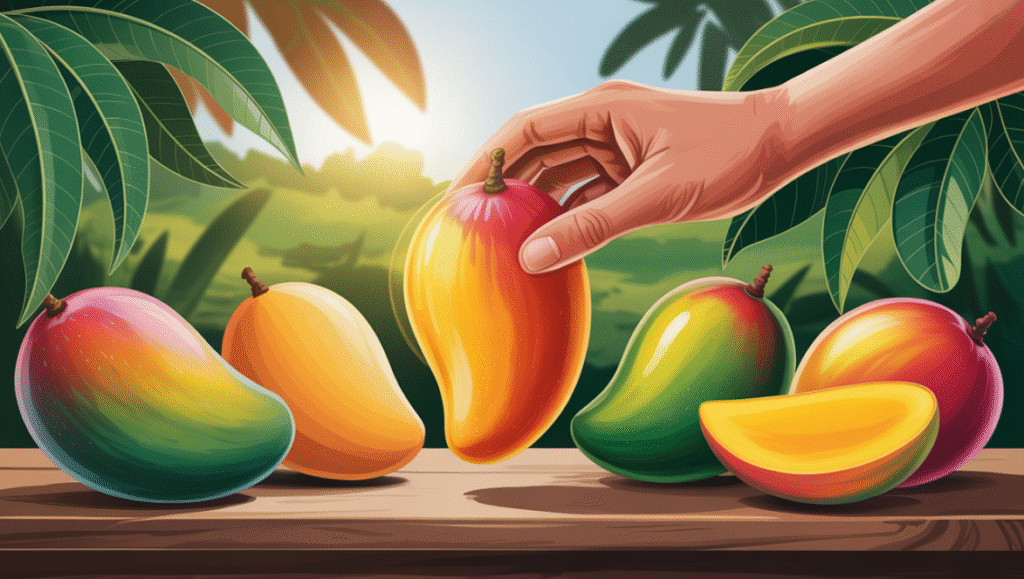
When selecting the best mango, you need to be aware of the various factors that impact the flavor, texture and use. There are a myriad of varieties to choose from with distinct flavors and distinct characteristics, picking the perfect mango can enhance your food creations whether you’re making a refreshing snack or dessert, pickle or a drink.
Factors to Consider: Taste, Texture, and Usage
- Taste: Mangoes are diverse in their sweetness, tartness and overall flavor. Certain varieties are sweet and rich such as Alphonso and Kesar, whereas others, including Totapuri and Banganapalli are mildly sweet or tangy tasting. When picking a mango think about the preference you have for a more sweet mango for snacking, or a less tart one for your savoury dishes.
- Texture: Mangoes’ texture can be various textures, from silky and non fibrillated to a little bit fibrous. If you prefer a silky and creamy texture, go for varieties such as Himsagar, Alphonso, or Amrapali. When making pickles or cooking dishes in which the mango’s firmness is required You can choose varieties with a more fibrous flesh, like Totapuri and Appemidi.
- Utilization: Consider what you will do with the mango. Certain varieties excel in particular cooking applications:
- For smoothies and desserts choose Alphonso, Malgova, or Mallika due to their delicious, sweet flavor and a smooth, spongy texture.
- If you’re making pickles Totapuri, Appemidi, and Langra are perfect due to their firmness and flavor.
- To drink refreshing juices and shakes There are varieties such as Kesar, Neelam, and Raspuri are excellent because of their high juiciness and moderate sweetness.
Best Varieties for Different Uses
- Best Mango Varieties for Desserts:
- Alphonso: It is rich and buttery perfect for mango ice-cream custards, cakes, and custards.
- Mallika:Sweet and tangy it is perfect in mango-based mousses, desserts and sorbet.
- Himsagar: famous for its soft, sweet pulp that is ideal for mango tarts as well as panna cotta.
- Best Mango Varieties for Pickles:
- Totapuri: A firm texture and tangy taste make it a perfect option for pickles with a spicy flavor.
- Appemidi: A little tart flavor and fibrous texture make it the perfect traditional Indian pickles.
- Langra: Its firm flesh and tangy flavor are ideal for the creation of mango Chutneys.
- Best Mango Varieties for Juices:
- Kesar: A sweet and aromatic ideal for smoothies and mango juice.
- Raspuri: known for its delicious pulp and mild sweetness, it is great for freshly squeezed juices.
- Neelam: Refreshing and mildly sweet, ideal for a cool, hydrating mango drink.
If you are aware of these aspects and thinking about how you want to utilize your mangoes you can pick the ideal selection to meet your requirements whether you are eating fresh, making a tasty dessert, or making traditional pickles.
Conclusion
The mangoes of India are more than simply a fruit that is seasonal; they’re a symbol of the country’s diverse agricultural heritage, cultural diversities and culinary traditions. With more than 1,000 varieties grown across diverse regions, each mango is unique in its taste and texture to the dining table. From the world-famous Alphonso to the distinct regional varieties such as Dashehari, Kesar, and Raspuri the variety in Indian mangoes is an authentic representation of India’s vast environments and climates.
If you like the sweet and creamy Alphonso or a spicy Totapuri or a silky Himsagar, each is unique in the kitchens and homes of the people throughout India. Mangoes don’t only serve consumed fresh but can also be used to make juices and desserts, pickles and salsas, demonstrating their versatility in a range of cooking uses.
While exploring the vast wide world of Indian mangoes, we suggest you to look beyond the well-known varieties and learn about the local particularities that bring unique flavours to the varied variety of mango cultivation in India. The GI-tagged variety such as Gir Kesar and the Malihabadi dashehari, to hybrid varieties such as Amrapali and Mallika There’s a vast universe of mangoes to be enjoyed and tasted.
Enjoy this mango-season with an attitude excitement and discover the many varieties available that India offers You’ll discover that every bite is an authentic reflection of the nation’s fascination with this adored fruit.
Want to discuss more:- Connect with us at Greenarium
FAQs
What are the most famous mango varieties in India?
Some of the most famous mango varieties in India include Alphonso (Hapus), Dashehari, Kesar, Langra, Totapuri, and Chausa. These varieties are well-known for their unique flavors, textures, and aromatic qualities, making them highly sought after across the country and even internationally.
Which mango variety is the best for making mango juice?
For making mango juice, the Kesar, Raspuri, and Neelam varieties are ideal due to their juicy pulp and mild sweetness. These varieties offer a smooth and refreshing flavor that is perfect for mango beverages.
What is the difference between Alphonso and Kesar mangoes?
The main difference between Alphonso and Kesar mangoes lies in their flavor and origin. Alphonso is known for its rich, buttery texture and sweet, tangy taste, and is often referred to as the “King of Mangoes.” In contrast, Kesar is slightly smaller, with a distinctly sweet and aromatic flavor, and is grown primarily in Gujarat. Both are famous varieties, but Alphonso is typically favored for its creamy texture, while Kesar is prized for its fragrance.
What are Geographical Indication (GI) tags, and which mangoes have them in India?
Geographical Indication (GI) tags are awarded to products that are uniquely linked to a specific region, reflecting their distinct qualities and heritage. Some of the mango varieties with GI tags in India include Malihabadi Dashehari (Uttar Pradesh), Gir Kesar (Gujarat), Himsagar (West Bengal), and Appemidi (Karnataka).
Which mango varieties are best for making pickles?
Totapuri, Appemidi, and Langra are some of the best mango varieties for making pickles due to their firm texture and tangy flavor. These varieties maintain their shape and offer a balanced tartness that enhances the spicy and savory flavors in traditional Indian pickles.
What are hybrid mango varieties, and can you give examples?
Hybrid mangoes are developed by crossing two different varieties to combine their best characteristics, such as flavor, texture, and yield. Some popular hybrid varieties in India include Amrapali (Dashehari × Neelum), Mallika (Neelum × Dashehari), and Arka Puneet (Alphonso × Janardhan Pasand). These hybrids often offer improved disease resistance and consistent fruiting.
How can I identify a ripe mango?
A ripe mango will generally have a slightly soft texture when pressed gently and will emit a sweet, fruity aroma near the stem. Depending on the variety, the skin color may also change as it ripens. For instance, Alphonso mangoes turn a deep golden yellow when ripe, while Kesar mangoes develop a more orange hue.
Are there any mango varieties that are good for making desserts?
Yes, many mango varieties are perfect for making desserts, especially those with sweet, creamy, and fiberless flesh. Some of the best varieties for desserts include Alphonso, Mallika, Himsagar, and Malgova. These mangoes are ideal for making mango ice cream, mango mousse, and mango cakes.
Which region in India is famous for mango cultivation?
Mangoes are cultivated across many regions in India, but Maharashtra, Uttar Pradesh, West Bengal, Andhra Pradesh, and Tamil Nadu are some of the most famous mango-growing states. These regions produce a variety of mangoes, including Alphonso, Dashehari, Kesar, Langra, and Fazli.
What makes Alphonso mangoes special?
Alphonso mangoes are considered special due to their rich, creamy texture, intense sweetness, and distinctive fragrance. They are often referred to as the “King of Mangoes” and are widely regarded as the best mango variety in terms of flavor. Grown primarily in Maharashtra, Alphonso mangoes are prized for their smooth, non-fibrous pulp, which makes them perfect for desserts and smoothies.
